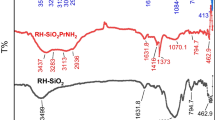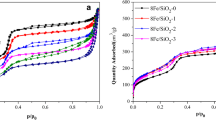Abstract
Rice husk, which is one of the abundant agricultural biomasses in nature, contains organic and inorganic elements, spastically silica. This waste is frequently managed via incineration, resulting in the contamination of soil, water, and air due to emission of greenhouse gasses and ash. In the present investigation, the potential of silica powder obtained from the rice husk was demonstrated by the removal of Cr(III) from the tannery wastewater. Different combinations of sulfuric, hydrochloric, and acetic acids were used as precipitation agents to produce silica through the conventional and ultrasound-assisted techniques. The mesoporous silica fabricated via the sonication indicated the larger pores, 22 nm, compared to that produced via the conventional method by the employment of sulfuric acid, 10 nm, leading to achieve an adsorption capacity ~385 mg g-1. Although both of applied techniques could develop mesoporous structure, precipitation should be carried out under sonication in the presence of acetic acid for the green production of silica with the appropriate adsorption performance. The conversion of rice husk into silica powder with specific surface area ~62 m2 g-1 could prevent the environmental pollution due to employment of acetic acid in the precipitation stage.










Similar content being viewed by others
Data availability
The datasets used and/or analyzed during the current study are available from the corresponding author on reasonable request.
References
Azat S, Korobeinyk AV, Moustakas K, Inglezakis VJ (2019) Sustainable production of pure silica from rice husk waste in Kazakhstan. J Clean Prod 217:352–359. https://doi.org/10.1016/j.jclepro.2019.01.142
Carmona VB, Oliveira RM, Silva WTL, Mattoso LHC, Marconcini JM (2013) Nanosilica from rice husk: extraction and characterization. Ind Crop Prod 43:291–296. https://doi.org/10.1016/j.indcrop.2012.06.050
Chuah TG, Jumasiah A, Aznia I, Katayon S, Choong SYT (2005) Rice husk as a potentially low-cost biosorbent for heavy metal and dye removal: an overview. Desalination 175(3):305–316. https://doi.org/10.1016/j.desal.2004.10.014
Costa JAS, Paranhos CM (2018) Systematic evaluation of amorphous silica production from rice husk ashes. J Clean Prod 192:688–697. https://doi.org/10.1016/j.jclepro.2018.05.028
Fahim NF, Barsoum BN, Eid AE, Khalil MS (2006) Removal of chromium(III) from tannery wastewater using activated carbon from sugar industrial waste. J Hazard Mater B 136:303–309. https://doi.org/10.1016/j.jhazmat.2005.12.014
Gomez-Salazar S (2014) Trivalent chromium removal from aqueous solutions by a sol–gel synthesized silica adsorbent functionalized with sulphonic acid groups. Mater Res Bull 59:394–404. https://doi.org/10.1016/j.materresbull.2014.07.035
Liou TH (2004) Preparation and characterization of nano-structured silica from rice husk. Mater Sci Eng A 364:313–323. https://doi.org/10.1016/j.msea.2003.08.045
Mor S, Manchanda CK, Kansal SK, Ravindra K (2017) Nanosilica extraction from processed agricultural residue using green technology. J Clean Prod 143:1284–1290. https://doi.org/10.1016/j.jclepro.2016.11.142
Noushad M, Rahman IA, Zulkifli NSC, Husein A, Mohamad D (2014) Low surface area nanosilica from an agricultural biomass for fabrication of dental nanocomposites. Ceram Int 40(3):4163–4171. https://doi.org/10.1016/j.ceramint.2013.08.073
Panpa W, Jinawath S (2008) Synthesis of ZSM-5 zeolite and silicalite from rice husk ash. Appl Catal B-Environ 90:389–394. https://doi.org/10.1016/j.apcatb.2009.03.029
Peres EC, Favarin N, Slaviero J, Almeida ARF (2018) Bio-nanosilica obtained from rice husk using ultrasound and its potential for dye removal. Mater Lett 231:72–75. https://doi.org/10.1016/j.matlet.2018.08.018
Pham TD, Bui TT, Truong TTT, Hoang TH, Le TS, Duong VD, Yamaguchi A, Kobayashi M, Adachi Y (2020) Adsorption characteristics of beta-lactam cefixime onto nanosilica fabricated from rice HUSK with surface modification by polyelectrolyte. J Mol Liq 298:111981. https://doi.org/10.1016/j.molliq.2019.111981
Phonphuak N, Chindaprasirt P (2015) Types of waste, properties, and durability of pore-forming waste-based fired masonry bricks. In: Pacheco-Torgal F, Lourenço PB, Labrincha JA, Kumar S, Chindaprasirt P (eds) Eco-Efficient Masonry Bricks and Blocks Design, Properties and Durability. Woodhead Publishing, Cambridge, pp 103–127. https://doi.org/10.1016/B978-1-78242-305-8.00006-1
Rimola A, Costa D, Sodupe M, Lambert JF, Ugliengo P (2013) Silica surface features and their role in the adsorption of biomolecules: Computational modeling and experiments. Chem Rev 113:4216–4313. https://doi.org/10.1021/cr3003054
Sankar S, Kaur N, Lee S, Kim DY (2018) Rapid sonochemical synthesis of spherical silica nanoparticles derived from brown rice husk. Ceram Int 44(7):8720–8724. https://doi.org/10.1016/j.ceramint.2018.02.090
Temel TM, İkizler BK, Terzioğlu P, Yücel S, Elalmış YB (2017) The effect of process variables on the properties of nanoporous silica aerogels: an approach to prepare silica aerogels from biosilica. J Sol-Gel Sci Technol 84:51–59. https://doi.org/10.1007/s10971-017-4469-x
Zulkifli NSC, Ab I, Rahmann IA, Mohamad D, Husein A (2013) A green sol–gel route for the synthesis of structurally controlled silica particles from rice husk for dental composite filler. Ceram Int 39(4):4559–4567. https://doi.org/10.1016/j.ceramint.2012.11.052
Author information
Authors and Affiliations
Contributions
SZHA performed the experiments and characterizations. AS supervised and conceptualized the data regarding the conversion of solid waste into products. SS was a major contributor in consultation, writing, reviewing, and editing the manuscript.
Corresponding author
Ethics declarations
Ethics approval and consent to participate
Not applicable.
Consent for publication
Not applicable.
Competing interests
The authors declare no competing interests.
Additional information
Responsible Editor: Ioannis A. Katsoyiannis
Publisher’s note
Springer Nature remains neutral with regard to jurisdictional claims in published maps and institutional affiliations.
Rights and permissions
Springer Nature or its licensor holds exclusive rights to this article under a publishing agreement with the author(s) or other rightsholder(s); author self-archiving of the accepted manuscript version of this article is solely governed by the terms of such publishing agreement and applicable law.
About this article
Cite this article
Amirhandeh, S.Z.H., Salem, A. & Salem, S. Treatment of tannery wastewater by silica nanoparticles produced from rice husk ash via a green route. Environ Sci Pollut Res 30, 13039–13047 (2023). https://doi.org/10.1007/s11356-022-23052-2
Received:
Accepted:
Published:
Issue Date:
DOI: https://doi.org/10.1007/s11356-022-23052-2




